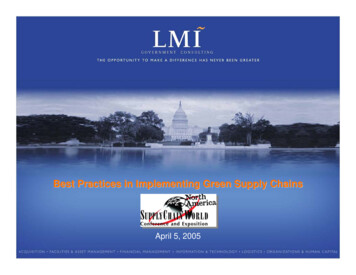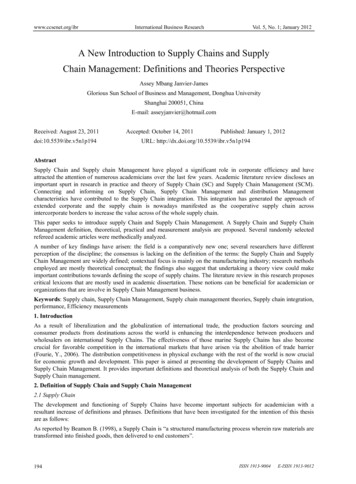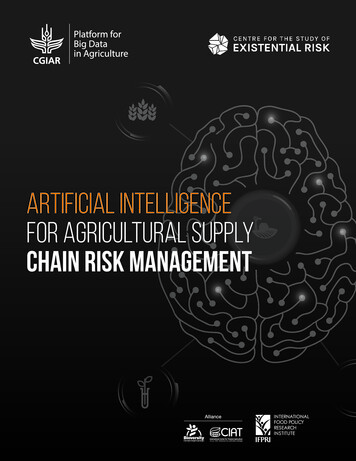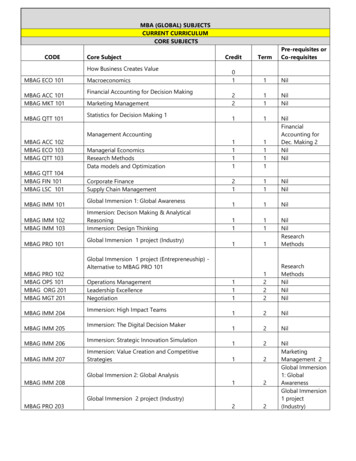
Transcription
International Journal of Mechanical And Production Engineering, ISSN: 2320-2092,Volume- 3, Issue-8, Aug.-2015“SUPPLY CHAIN MANAGEMENT: FOR THE INDIAN” AGRI FOODSECTOR1NEHA GAUTAM, 2S.S.CHAUHAN, 3M.K.GHOSH1M.Tech Scholar, 2Industrial Engineering & Management, professor,3Department of Mechanical Engineering, ProfessorDepartment of Mechanical Engineering MIT Mandsaur, 458001E-mail: 1gautam.neha44@gmail.com, 2sanjeev.chauhan@mitmandsaur.info, 3mk.ghosh@mitmandsaur.infoAbstract- Indian civilization is one of the oldest civilizations, and therefore it has the rich heritage and legacy of the variousschools of thoughts. It may really be beneficial to learn from the core principles of the yesteryears so as to extract thestanding principles that provided the vitality and the vigour for the Indian civilization to grow and flourish from the timeimmemorial till today. The present research work reflects the existing supply chain architecture of the Indian Agri-foodsector and provides areas where concentration is needed for its improvement. The research work is followed by designing anavant-garde sustainable supply chain model named as “Project Samridh Bharat” for Indian Agri-food sector. The presentstudy also highlights the impact of FDI in Indian scenario and is followed by developing a performance measurementframework for the Agri-food supply chain network by an analytical decision making tool named analytical hierarchy process(AHP).3. Technology and advanced techniques aredisseminated among producers, packagers andprocessors.4. Ownership rights pass from producers toprocessors and ultimately to marketers.5. Information on current customer demand andon retail level product preferences pass backfrom retailers to producers.INTRODUCTIONEvery human being has certain desire (needs andwants). Needs being the basic state of human desirethat is needed for survival such as air, water, food,cloth, shelter and Wants being the secondary desirefor living satisfaction such as cars, processed food,etc. In economic terms these needs and wants createsdemands and hence to fulfill these demands someonehas to supply the desired things. These creates anever ending process of demand and supply and takesa form of chain known as supply demand chaincommonly known as supply chain.What is supply chain?A supply chain is an integration of:-All facilities,functions, activities, associated with the flow andtransformation of goods and services from backend(production house) to front end (customer base). Anintegrated group of processes to “source,” “make,”and “deliver” products.All process which involves the flow of informationfrom backend to frontend and vice versa.According to Cooper et al. (1) Supply chains are theconduits through which:1. Products move from producers to consumers.2. Payments, credit and working capital movefrom consumers to producers.Supply Chain ManagementIn present times, Supply chain management (SCM)has received a great deal of attention from worldwidepractitioners and researchers both from academic andindustrial background. Due to the emerging trends ofglobalization and the increasing saturation ofmarkets, competition has become more intense inrecent years. These competitive environments haveforced companies to collaborate more closely usingthe concept of supply chain management. Supplychain management is an approach to design valuechains or marketing chains by optimizing the interorganizational flow of material, information andcapital in order to reduce the system wide costs andenhance customer value.A supply chain management is:A set of approaches used to efficiently integrate :– Suppliers– Manufacturers/producers– Warehouses– Distribution centers– Consumer baseSo that the product is produced and distribute :– In the right quantities– To the right locations– At the right timeSystem-wide costs are minimized and service levelrequirements are satisfied.Indian Agri-food sector“Supply Chain Management: For The Indian” AGRI Food Sector60
International Journal of Mechanical And Production Engineering, ISSN: 2320-2092,Agriculture was and is one of the largest employmentsectors in the world and for India it’s the major or theprimary source of employment. More than half ofIndian population depends on agriculture as theirprimary source of livelihood . Agriculture is thebackbone of Indian Economy. The occupationalstructure of Indian workforce can be divided intothree classes. Agri-food sector constitute the primarysector of the occupational structure. India is the fruitand vegetable basket of the world. India being a homeof wide variety of fruits and vegetables holds aunique position in production figures among othercountries. Estimates currently suggest that India rankssecond in terms of farm output, first being china.Although there have been a large number of peopleinvolved in agriculture in India, still there is a foodcrisis. In India, agriculture got its dimension duringgreen revolution. This introduced several newscientific methods, which increased the foodproductivity. But still, In India, 37 % live belowpoverty line and several hundred die due tomalnutrition. Although the green revolution in Indialed to sizeable increase in terms of productivity thattoo in certain crops but the overall growth in terms offarmers economic status is unremarkable.Agriculture derives its importance from the fact that ithas vital supply and demand links with themanufacturing sector. The basic characteristic whichis common in agriculture and manufacturing sector is:“Production”Volume- 3, Issue-8, Aug.-2015economy of the country itself. Statistical figures showthat 70% of the world population lives in rural areasand only 38% of the land in the world is used foragriculture cultivation, depleting from time to time,due to industrial expansion and human populationgrowth (World Bank, 2010). Achieving sustainabilityin agricultural contexts means meeting threechallenges commonly known as 3P s, that are: (a)profit– strengthening the viability andcompetitiveness of the agricultural sector; (b) planet –the ecological challenge of promoting goodenvironmental practices; and (c) people the socialchallenge to improve the living conditions andeconomic opportunities in rural areas. Consumer’swants and preferences are not transmitted directly tothe farmers who produce or plant the crops. Hence,there are missing links in connecting consumers atone end, and farmers at the other have summarizedthe following specific aspects of Agri-food supplychains:1. Shelf-life constraints for raw materials.2. Perish ability of products.3. Long production throughput time.4. Seasonality in production.5. Conditioned transportation and storagerequired.6. Storage-buffer capacity restrictions, whenmaterials or products can only be kept inspecial containers.7. Governmentalrulesconcerningenvironmental and consumer-related issues(CO2 emission, food-safety issues).8. Physical product features like sensoryproperties such as taste, odour, appearance,colour, size and image.9. Convenience of ready-to-eat meal.A general optimization problem related to Agri-foodsupply chain can be written as:- Objective Function1. Minimize the sum of costs of production andtransportation.2. Maximize the profit of farmers.Constraints1. Meeting demand.2. Respect the available capacity at production.3. Respect the available capacity at supply.4. Respectthe available capacity atdistribution.There are some rules to be followed for attainingfruition in supply chain design optimization:1. Objectives - must be quantified and measurable2. Models - must faithfully represent requiredlogistics processes3. Variability - must be explicitly considered4. Data - must be accurate, timely, andcomprehensive5. Integration - must support fully automated datatransfer6. Delivery - must provide results in a form thatfacilitates execution, management and control7. People - must have the domain and technologyChallenges in Indian Agri-food SectorAccording to Hon’ble Union Minister SharadPawar,“Agriculture sector is witnessing radical changes andchallenges at national and global level. The demandfor agricultural commodities is steeply rising; foodpreferences of the next-generation consumers arechanging; and agriculture sector is struggling withdecelerating profitability which is dragging itsperformance. The emerging challenges andopportunities call for a paradigm shift in theinnovation driven agricultural research system toconnect inventions with all the stakeholders in theentire food supply chain”. Two different types ofcontrasting trends have been noticed in present timeswith respect topresent Indian scenario:1. India is being recognized as the globalpower in the key economic sectors withconsistent high economic growth and2. Its slow growth observed in the agriculturesector is causing concerns for the future foodand nutritional security of the country.Agri-food Supply Chain ManagementThe agricultural sector provides an importantcontribution in the development of a country due toits contribution in both economic and environmentaldevelopment. As the backbone of the development inmost of the developing countries, agriculture holdsimportant roles in deciding the stability of the“Supply Chain Management: For The Indian” AGRI Food Sector61
International Journal of Mechanical And Production Engineering, ISSN: 2320-2092,expertise required to support the models, data,and optimization engines8. Process - must support optimization and havethe ability to continuously improve6.Review on Existing Traditional Indian Agri-foodSupply Chain NetworkIn the case of the agricultural sector, India’s supplychain is one of the most fragmented and inefficientones in the world resulting in wastage of largequantities of food grains, vegetables and fruits. About25-30 percent of vegetables and fruits are destroyedbefore they come to the market. Apart from this,output is procured through unhygienic practices. Thismeans farmers and consumers bear the costs of thewastage. The agricultural markets are not functioningin a proficient manner. Apart from inefficiencies indistribution, including wastage of agriculturalproduce, the farmers suffer due to exploitation bytraders.Volume- 3, Issue-8, Aug.-2015is an estimate value adopted from variouspast researches and planning commissiondata and market survey.Marketing elements in the chain are assumedby interviewing from market.Disadvantages associated with the Existing modelThe disadvantages associated with different elementsalong the traditional supply chain model can besummarized in the following way:At farmer’s side:1. Low return on investments.2. Prices delinked from the market.3. Unavailability of adequate infrastructure.4. High Credits leading to debt trap or povertytrap.5. High commission charges.6. High transportation cost.7. Lack of marketing option at farm gate.8. Distress selling.At commission agent’s side:9. Non value adding player.10. Unscientific handling.11. Quality deterioration.12. Risk free income.13. Charges huge commissions from farmers. Attrader’s side:14. No infrastructure for grading15. Large wastages due to ineffectivetransportation facilities.At wholesaler’s side:1. Large wastage.2. No control on quality.At retailer’s side:No control on quality.No infrastructure for proper storage.At customer’s side:1. High prices.2. Low quality products.3. Limited alternativesProblem Analysis MethodologyThe present research work is based on a real worldproblem and then it is modelled in the ideal worldwith certain assumption in order to meet with thedesired criteria. A real world problem is taken, in thepresent case the traditional Indian Agri-food supplychain network. It is then modelled in the ideal worldwith certain assumptions and after then it is analyzedwith respect to different criteria’s (in the present casewastages and supply chain cost). There is no singlemodel of procurement and distribution for IndianAgri-food products. It depends on various factors,such as type of product, place, etc. The Existingtraditional Indian Agri-food supply chain networkshown below is assumed by the author, by consultingwith the vegetable vendor of M.P. (C.G.).Proposed model for Indian Agrifood SupplyChain Network ProjectSamridhBharat”FEATURES OF THE PROPOSED MODEL1. No commission agents involved. Cost effective.2. Complete supply demand management withsoftware support.3. Every farmer members are the shareholders.4. Less handling so less wastages.5. Proper food grading according to food safetymeasures.6. Retail counters at village and city for BPL cardholders and NGOs.7. Proper financial and technical support to farmers.8. Proper waste management system for entire foodwastages.9. Proper warehousing and inventory management.Feature and benefits associated with the ProposedAssumptions:1. Single product type.2. Costs are calculated on per kg basis.3. Selling Prices are approximated with themarket report.4. Commission charges are approximated withthe market report.5. Wastage percentage used in the calculation“Supply Chain Management: For The Indian” AGRI Food Sector62
International Journal of Mechanical And Production Engineering, ISSN: 2320-2092,Volume- 3, Issue-8, Aug.-2015Level) Trader (Mandi) Commission Agent(Mandi Level) Wholesaler Retailers ConsumersmodelThe salient features of the proposed model are:1. Transportation facilities for farmers.2. Crop Insurance facilities for farmers.3. Education and training.4. Medical facilities.5. Technical support.MODEL-2**Retail Chain MarketFarmer Trader Retail Chain ConsumersMODEL-3 (Proposed Model)Functions associated with the proposed modelX* FarmerOwnedCo-OperativeswithGovernment-Private PartnershipFarmers X* Local Vendors/Retailers ConsumersCost Benefit TableThe cost benefit ratios for the above three modelsare calculated in the tabular form.Assumptions:Product TomatoQuantity Handled 2600kgCost of Cultivation is assumed by consulting withfarmers of M.P. (C.G).Cost-Benefit AnalysisThe benefits associated with the proposed model are:1. Optimization in resource use and outputmanagement.2. Increase in farm income3. Shares on the profit.4. Reduced storage lossesCost Benefit AnalysisThis section evaluates the performance of theexisting model, Modern retail model and theproposed model on the basis of cost-benefit ratio(CBR). A cost-benefit analysis helps in determiningthe profitability of farmers. The cost-benefit ratio iscomputed as an indicator of economics of investmentcriterion. This ratio helps in judging the feasibility ofinvesting in the proposal. The cost-benefit ratio is asimple calculation that depicts the total financialreturn for each rupee invested in cultivation. If thecost-benefit ratio is 1.50, it means that for everyrupee invested in one hectare of land undercultivation for a given produce, the return is aboutRs. 1.50 per hectare after the sale of the produce.The cost-benefit ratio is defined as:Gross ReturnsCost-benefit ratio (CBR) Cost of CultivationWhere: Gross Returns Yields * Selling PriceDescription of the ModelsThe models used for the cost benefit analysis aredescribed below:-From the above table it is clear that proposed modeloutperforms more compared to the other models,when all the features of the proposed model areconsidered.FACTORS AFFECTINGEFFICIENCYSUPPLYCHAINModeling of Supply chain efficiency can be done byfollowing way:Z f (X1, X2 XN)Where, Z Supply Chain Efficiency (%) X1 Pricereceived by farmers (Rs.) X2 Price paid byconsumer (Rs.)X3 Wastages in monetary term along the supplychain (Rs.) X4 Marketing cost (Rs.)Desired outputs include multi objective functionswith conflicting objective. Desired output includesMODEL-1Farmer Local Commission Agent (Village“Supply Chain Management: For The Indian” AGRI Food Sector63
International Journal of Mechanical And Production Engineering, ISSN: 2320-2092,High profit on farmer side with Low cost price oncustomer side.Introduction to Supply Chain ement is a management strategy that helpscompanies to enhance their performance levels in allthe desired areas of the supply chain network. Theidea behind the performance measurement techniqueis to first optimize the desired goal then to prosper, toget high operational excellence. Proper measurementleads to high market share and correspondinglycontinuous improvement of the organization. Thevariables to be measured are known as performanceindicators. The choice of variables depends upon thesupply chain network under consideration. Theperformance indicators can be qualitative (customersatisfaction, producer satisfaction etc) andquantitative (total supply chain cost, profit etc).Volume- 3, Issue-8, Aug.-20151.2.3.4.5.To set desired performance goals.To evaluate the performance gaps.To understand the actual market demand.To develop supply chain priorities.To compare theoretical limits and actualneeds.6. To obtain market feedback.According to Lambert &Pohlen a well definedsupply chain measurement system increases thechances for success by aligning process acrossmultiple firms and targeting the most profitablemarkets and obtaining a competitive advantagethrough differentiated services and lower cost.AN AHP APPROACH FOR DEVELOPINGTHE INDIAN AGRI-FOOD PERFORMANCEMeasurement FrameworkThe analytic hierarchy process (AHP) is aquantitative tool for making decisions with multicriteria developed by Saaty and has been applied to awide variety of managerial decisions and socioeconomic judgment process. The AHP is a commonlyused tool because it can solve unstructured problemsin different areas of human needs and interests, suchas political, economic, social and managementsciencesThe Analytic Hierarchy Process (AHP) involves pairwise comparisons of criteria’s. The weightage isgiven according to nine point priority scales . Thecomparisons are made using priority scale of absolutejudgements that represents how much more oneelement dominates another with respect to a givenattribute. The judgements may be inconsistent, andhow to measure inconsistency and improve thejudgements, when possible to obtain betterconsistency is a concern of the AHP.SUPPLY CHAIN PERFORMANCEMEASUREMENTSupply chain performance measurement is amanagement strategy that helps companies toenhance their performance levels in all the desiredareas of the supply chain network. The idea behindthe performance measurement technique is to firstoptimize the desired goal then to prosper, to get highoperational excellence. Proper measurement leads tohigh market share and correspondingly continuousimprovement of the organization. The variables to bemeasured are known as performance indicators. Thechoice of variables depends upon the supply chainnetwork under consideration. The performanceindicators can be qualitative (customer satisfaction,producer satisfaction etc) and quantitative (totalsupply chain cost, profit etc). The tools or the modelsused for performance measurement also varyaccording to the data available and the goals to beevaluated.Performance measurement is critical for companies toimprove supply chain effectiveness and efficiency.Adequate performance measurement indicators mustbe identified for the supply chain network understudy and a proper methodology is to be developedfor better result. The main purpose for developingthis framework is to obtain feedback relative to thedesired set of goals and once loopholes are evaluated,the company can change its strategy for nt affects the decision making through theevaluation of past trends and benchmarkingtechniques. The choice of appropriate supply chainperformance indicators is rather complicated due tothe presence of multiple inputs and multiple outputsin the system. This issue becomes even moreproblematic in the field of food and agribusiness dueto specific characteristics of Agri-food supply chains.The answer to the above question can be given infollowing points:-Marketing Agent Selection by AHPThis portion is related with the selection of amarketing agent from farmer’s point of view. Theanalytical tool used for making the decision is AHP.The objective is to select the marketing agent fromthree alternatives available on the basis followingcriteria. The various criteria are:Price- Farmers want high price for their products.Credits- Sometimes farmers need credits to purchasefarm equipments and other farming needs.Trainings- Trainings are given by certainGovernmental bodies or NGOs with respect tofarming and cultivation techniques in order to raisethe productivity and other measures.SummaryThe topic of performance measurement isencountering increasing interest in both the academicand managerial areas. Also, there is a need of realtime research work in those sectors of the Indianscenario which directly affects the economy of thecountry“Supply Chain Management: For The Indian” AGRI Food Sector64
International Journal of Mechanical And Production Engineering, ISSN: 2320-2092,Volume- 3, Issue-8, Aug.-2015Indian agri-food supply chain network. Simulation tools for real time modeling. Design of effective management informationsystem and decision support system. Effective post harvest management by localwarehousing.There is a vast area for research to be carried out nary approaches can be applied to acommon problem for obtaining sustainable results.CONCLUSIONSREFERENCEThe industrial engineering and management conceptscan play an important role in designing anddeveloping a sustainable supply chain network.Following are the list of objectives that can besuitably evaluated and attained by effectivelyapplying the industrial engineering and managementconcepts in the domain of Agri-food supply chains: Efficient Agri-food supply chain network design. Effective planning of food distribution system. Handling logistics issues. Development of performance measurementsystem for Agri-food supply chain. Integration of IT support for developing effectiveplanning strategy. Quality control along the chain. Design of distribution networks. Marketing agent selection. Food Supplier selection. Warehouse management. Vehicle routing along the chain. Warehouse location problem. Production system design. . Effective supply chain Cost accounting usingABC including time constraint. Optimization of production system. Logistic network design and planning. Designing cold storage infrastructure. Enhanced packaging and grading techniques. Cost benefits analysis using RFID technique for[1]Cooper, M.C., Lambert, D.M., Pagh, J.D. (1997). “SupplyChain Management: More than a Name for Logistics”,International Journal of Logistics Management, Vol. 8, No.[2] Lambert, D.M., Cooper, M.C. (2000). “Issues in SupplyChain Management”, Industrial Marketing Management 29,pp. 65-83.[3] Mentzer, J.T., Dewitt, W., Keebler, J.S., Min, S., Nix, N.W.,Smith, C.D., Zacharia, Z.G. (2001). “Defining supply chainmanagement”, Journal of Business Logistics 22 (2), 1–26.[4] Chopra, S., Meindl, P. (2007). Supply Chain Management:Strategy, Planning & Operation 3rd Edition. PearsonPrentice Hall, ISBN 0 – 13 – 173042 – 8.[5] Kumar, B.P. (2011). “Supply Chain Management: Anexploring areas of management research”. JSPM’SJayawant Institute of Management Studies Tathawade,Pune, India 2.[6] Agarwal, A., Shankar, R., Tiwari, M.K. (2006). “Modelingthe metrics of lean, agile and leagile supply chain: an ANPbased approach”, European Journal of OperationalResearch,173, 211–225.[7] Basu, R., Wright, N. J. (2007). Total Supply ChainManagement. 1st Ed. USA: Butterworth-Heinemann.Blanchard, D. (2007). Supply Chain Management: bestpractices. 1stEd. Canada: John Wiley and sons, Inc.[8] Li, S., Ragu-Nathan, B., Ragu-Nathan, T.S., Subba Rao, S.(2006). “The impact of supply chain management practiceson competitive advantage and organizational performance”,Omega 34 (2) 107-124.[9] Trkman, P., Indihar Stemberger, M., Jaklic, J., Groznik, A.(2007). “Process approach to supply chain integration”,Supply Chain Management-an International Journal, 12 (2),116–128.[10] Pohja, T.L. (2004). “Some theoretical foundations of SupplyChain Management and Supply Networks: the role of socialnetworks in selecting partners”, 20th IMP GroupConference. “Supply Chain Management: For The Indian” AGRI Food Sector65
"Supply Chain Management: For The Indian" AGRI Food Sector 60 "SUPPLY CHAIN MANAGEMENT: FOR THE INDIAN" AGRI FOOD SECTOR 1NEHA GAUTAM, 2S.S.CHAUHAN, 3M.K.GHOSH 1M.Tech Scholar, 2Industrial Engineering & Management, professor, 3Department of Mechanical Engineering, Professor Department of Mechanical Engineering MIT Mandsaur, 458001











